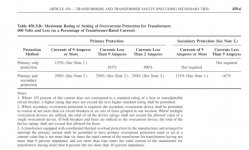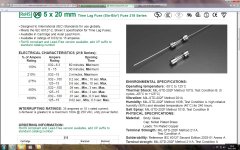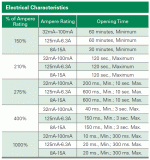In Texas, the NFPA may have some say in your home insurance stipulations.
The NFPA produces and maintains the NFPA 70 code (the ubiquitous 'National electrical code'), used and enforced in most, if not all, US electrical installations.
Last edition I have is from 2005, but the basics do not change much.
Their take on transformer protection (<600V) is included.
It is more complicated than just "3x transformer rating".
I also agree with Andrew and tend to select the standard 125% of load rating (time delay type).
(This by the way is also how fuses are selected for motor protection, as opposed to branch circuit protection).
Worst that may happen is to have a nuisance blow.
Then it is time to re-evaluate and maybe look at a soft start circuit.
Something to consider:
A small transformer with a short on the secondary may not draw more than 3x full load current on the primary due to internal losses.
A 3x fuse will not blow.
The transformer will heat up and may eventually catch fire, if not protected by an internal thermal fuse.
Same for bigger transformers connected to faulted, but not shorted, loads.
The transformer should contain this thermal fuse if it complies to regulations, but what if it does not?
The NFPA produces and maintains the NFPA 70 code (the ubiquitous 'National electrical code'), used and enforced in most, if not all, US electrical installations.
Last edition I have is from 2005, but the basics do not change much.
Their take on transformer protection (<600V) is included.
It is more complicated than just "3x transformer rating".
I also agree with Andrew and tend to select the standard 125% of load rating (time delay type).
(This by the way is also how fuses are selected for motor protection, as opposed to branch circuit protection).
Worst that may happen is to have a nuisance blow.
Then it is time to re-evaluate and maybe look at a soft start circuit.
Something to consider:
A small transformer with a short on the secondary may not draw more than 3x full load current on the primary due to internal losses.
A 3x fuse will not blow.
The transformer will heat up and may eventually catch fire, if not protected by an internal thermal fuse.
Same for bigger transformers connected to faulted, but not shorted, loads.
The transformer should contain this thermal fuse if it complies to regulations, but what if it does not?
Attachments
Last edited:
AndrewX obviously has his own ideas which are outside of industrial standars.
Commercial designs use the formulae that I have been using. ie 3 X.
Can you quote a source or reference re. this?
Discrete, your post 21 shows 300% for low power transformers.
This 300% is the same as 3times when the primary current rating is <2Aac.
I am not arguimg against this fuse rating.
I am drawing attention to how hot a faulty piece of equipment may become, because the 3times rule fuse passes that fault current for far longer than is necessary.
That's why I recommend and use 1times (= close rated). I even run some equipment with less than close rated fusing, simply because I do not get any nuisance blowing with those items.
This 300% is the same as 3times when the primary current rating is <2Aac.
I am not arguimg against this fuse rating.
I am drawing attention to how hot a faulty piece of equipment may become, because the 3times rule fuse passes that fault current for far longer than is necessary.
That's why I recommend and use 1times (= close rated). I even run some equipment with less than close rated fusing, simply because I do not get any nuisance blowing with those items.
Hi Andrew,
I totally agree with this.
We live in wooden boxes over here, full of hydrocarbon fuels (synthetics/plastics).
Better safe than sorry.
Of course for North America 2A is only 230VA, so that would imply the 167% rule for most power amps with non-fused secondaries.
Even then I have a 300VA amp (on 115Vac) with a 3.15 A slow blow primary fuse (~120%) and no soft start. No blows yet.
PS. The 125% rating, as opposed to 100% rating, for fuses is general rule to de-rate for ambient temperature.
I totally agree with this.
We live in wooden boxes over here, full of hydrocarbon fuels (synthetics/plastics).
Better safe than sorry.
Of course for North America 2A is only 230VA, so that would imply the 167% rule for most power amps with non-fused secondaries.
Even then I have a 300VA amp (on 115Vac) with a 3.15 A slow blow primary fuse (~120%) and no soft start. No blows yet.
PS. The 125% rating, as opposed to 100% rating, for fuses is general rule to de-rate for ambient temperature.
I am drawing attention to how hot a faulty piece of equipment may become, because the 3times rule fuse passes that fault current for far longer than is necessary.
That's why I recommend and use 1times (= close rated). I even run some equipment with less than close rated fusing, simply because I do not get any nuisance blowing with those items.
Last edited:
Hi Andrew,
I totally agree with this.
We live in wooden boxes over here, full of hydrocarbon fuels (synthetics/plastics).
Better safe than sorry.
Of course for North America 2A is only 230VA, so that would imply the 167% rule for most power amps with non-fused secondaries.
Even then I have a 300VA amp (on 115Vac) with a 3.15 A slow blow primary fuse (~120%) and no soft start. No blows yet.
PS. The 125% rating, as opposed to 100% rating, for fuses is general rule to de-rate for ambient temperature.
In failure mode the current drawn rapidly exceeds the norm.
The 3 x rating is to prevent changing fuses every 5 mins due to transient loads.
In Texas, the NFPA may have some say in your home insurance stipulations.
The NFPA produces and maintains the NFPA 70 code (the ubiquitous 'National electrical code'), used and enforced in most, if not all, US electrical installations.
Last edition I have is from 2005, but the basics do not change much.
Their take on transformer protection (<600V) is included.
It is more complicated than just "3x transformer rating".
I also agree with Andrew and tend to select the standard 125% of load rating (time delay type).
(This by the way is also how fuses are selected for motor protection, as opposed to branch circuit protection).
Worst that may happen is to have a nuisance blow.
Then it is time to re-evaluate and maybe look at a soft start circuit.
Something to consider:
A small transformer with a short on the secondary may not draw more than 3x full load current on the primary due to internal losses.
A 3x fuse will not blow.
The transformer will heat up and may eventually catch fire, if not protected by an internal thermal fuse.
Same for bigger transformers connected to faulted, but not shorted, loads.
The transformer should contain this thermal fuse if it complies to regulations, but what if it does not?
Once the windings start to fail - transformer will quickly blow its correctly specified fuse.
The mains fuse is to protect the transformer not its load.
NEC, ANSI, UL, ISO, etc are intended to provide minimum requirements to protect against fires and provide general safety. All too often builders use them as a design specification, which they are not. You won't fail disastrously if you blindly follow them, but oftentimes an improved design will build more conservatively.
Is there anything wrong with placing #12 wire on a 15A circuit breaker? Certainly not- I am still protected, and have the bonus of less voltage drop at my equipment. I could blindly follow the NEC and use #14 wire. Both approaches are acceptable. One approach provides improved performance, which should be weighed against practical and economic considerations.
For fusing a piece of equipment (headphone amplifier) that runs at a very constant load, my opinion is that optimized fuse selection is to select a slo blo just over the measured actual current draw of the amp. Required? of course not. I could pick 300% and not ever cause a fire. Then again, if I do ever have a failed rectifier or shorted PS capacitor, my desire is to pop that fuse as fast as possible. It is a personal choice to optimize the protection to the equipment (both transformer as well as load).
We need to recognize the difference between requirements and design choices.
Is there anything wrong with placing #12 wire on a 15A circuit breaker? Certainly not- I am still protected, and have the bonus of less voltage drop at my equipment. I could blindly follow the NEC and use #14 wire. Both approaches are acceptable. One approach provides improved performance, which should be weighed against practical and economic considerations.
For fusing a piece of equipment (headphone amplifier) that runs at a very constant load, my opinion is that optimized fuse selection is to select a slo blo just over the measured actual current draw of the amp. Required? of course not. I could pick 300% and not ever cause a fire. Then again, if I do ever have a failed rectifier or shorted PS capacitor, my desire is to pop that fuse as fast as possible. It is a personal choice to optimize the protection to the equipment (both transformer as well as load).
We need to recognize the difference between requirements and design choices.
I'm about 25 posts late with this light bulb tester:
http://www.diyaudio.com/forums/power-supplies/167579-light-bulb-tester.html
http://www.diyaudio.com/forums/power-supplies/167579-light-bulb-tester.html
Thanks again for all of the replies and the links.
I might have missed something, but for my 50 VA transformer, it seems that I should either purchase a 1.5 amp quick-blow fuse or a .5 amp slow-blow fuse. I mistakenly purchased a bunch of 3 amp quick-blow fuses so I will definitely move down to one of the recommended ones. I'm guessing that the choice between these two recommended fuses comes down to personal preference?
Edit: The IEC socket/ fuse holder that I purchased accepts GMA fuses. Since I cannot find these in values smaller than 2 amps quick-blow, would this protect adequately?
I might have missed something, but for my 50 VA transformer, it seems that I should either purchase a 1.5 amp quick-blow fuse or a .5 amp slow-blow fuse. I mistakenly purchased a bunch of 3 amp quick-blow fuses so I will definitely move down to one of the recommended ones. I'm guessing that the choice between these two recommended fuses comes down to personal preference?
Edit: The IEC socket/ fuse holder that I purchased accepts GMA fuses. Since I cannot find these in values smaller than 2 amps quick-blow, would this protect adequately?
Last edited:
If you look at the datasheet for your transformer - I have looked at a generic 50VA transformer - the inrush current can be as high as 5A for half a cycle.
Most Time lag fuses will not rupture during this time.
Hence a 1.5A Time Lag fuse experiencing 400% of its rated current will last for the 20mS of the inrush current without rupturing.
Anything smaller may rupture at the moment of turn ON.
Most Time lag fuses will not rupture during this time.
Hence a 1.5A Time Lag fuse experiencing 400% of its rated current will last for the 20mS of the inrush current without rupturing.
Anything smaller may rupture at the moment of turn ON.
Attachments
Last edited:
If there is catastrophic failure inside the transformer or in the rectifier immediately after the transformer, then the mains fuse in the Primary feed must rupture. !!!!!!
If you use the normal rule for motors and transformers of mains fuse rating = 3 times VA rating / mains voltage, then you end up with a fuse that may pass fault current for a long time until it eventually ruptures. Use close rated fusing to suit the transformer after start up and the worst case normal (not faulty) operating conditions.
Close rated fuse value = VA rating / mains voltage.
Most transformers will not start reliably with close rated fusing. They usually need a soft start. Using T rated fuses helps avoid these nuisance fuse failures.
I agree with AndrewT here. Some of the products the company I work for use mains fed linear power supplies, and they all have close rated slow blow fuses.
One particular product is about as closed rated as it gets. It's equipped with a >300 VA toroid and a combined capacitance of nearly 40 mF, without soft start. And yet, only 1.6 A mains fuses are allowed (for 230 V mains). Fuses with an I2t-rating of >20 (like the Littelfuse 218 series) make this possible, though.
I have yet to see mains powered products with 300% quick blow fuses...
Last edited:
If you look at the datasheet for your transformer - I have looked at a generic 50VA transformer - the inrush current can be as high as 5A for half a cycle.
Most Time lag fuses will not rupture during this time.
Hence a 1.5A Time Lag fuse experiencing 400% of its rated current will last for the 20mS of the inrush current without rupturing.
Anything smaller may rupture at the moment of turn ON.
I don't understand why you would recommend a 1.5 A timelag fuse for a mere 50 VA transformer.
Based on the datasheet of the Littelfuse 218 series, I'd agree that it should be a 0.5 A time lag fuse (1000% for 20-300 ms), NOT 1.5 A.
Attachments
Last edited:
For the sake of a few pence - try it.
If the fuse lasts then use the smallest fuse possible.
This might work and it might not. Thanks to an error in taking over the BOM in our own system we used T1.25 A fuses in a product that should have T3.15 A. This went unnoticed for years until one blew at power up and our customer discovered the mistake.
You are expecting a 500mA fuse to work at 1000%. all-be-it for 20mS.
But that is exactly what this type of fuse has been designed for!
Last edited:
- Status
- This old topic is closed. If you want to reopen this topic, contact a moderator using the "Report Post" button.
- Home
- Amplifiers
- Power Supplies
- Mains Transformer Safety


